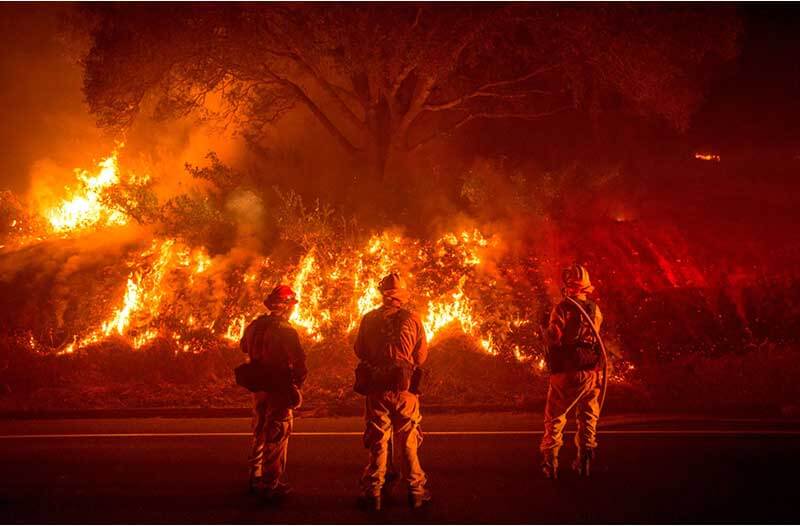- Wildfires are increasing in frequency and intensity
- WIFIRE uses big data to predict and fight wildfires
- Artificial intelligence could also help predict wildfires before they start
The tremendous impact climate change has on our planet is becoming more and more pronounced and terrifying with each passing day. Natural disasters like earthquakes, floods, and hurricanes – which used to occur with much less frequency – are becoming an increasingly common occurrence, with the next one always seeming to be lurking right around the corner.
One of the most devastating and deadliest consequences of climate change has been the increase in the frequency and intensity of wildfires, particularly in the North American region. And with global temperatures expected to keep rising, finding a more effective way to deal with this growing problem as soon as possible is becoming increasingly critical. Some researchers believe that technologies like artificial intelligence, machine learning, and big data could be the solution we’re looking for.
Wildfires are increasing in frequency and intensity
Over the past decade, wildfires have caused more than $5 billion worth of damages in the United States. According to the National Interagency Fire Center, more than 52,000 wildfires have been recorded in 2018 so far, burning more than 3.4 million square kilometres of land and destroying thousands of homes in the process. The Campfire alone, which broke out in California’s Butte County on November 8, 2018, has already destroyed more than 11,000 homes and killed 77 civilians, making it the deadliest and most destructive wildfire in the history of the state. The vast majority of wildfires, around 90 per cent of them, are caused by people, while the remaining 10 per cent are caused by naturally occurring phenomena, such as lightning. Wildfires can spread incredibly quickly, reaching speeds of up to 23 kilometres per hour and devouring everything that gets in their way. The one thing that makes wildfires particularly dangerous is that they’re highly unpredictable. They can change direction in a matter of seconds, forcing firefighters to have to constantly adapt to changing conditions on the ground. And this is precisely where artificial intelligence, machine learning, and big data can lend a helping hand.

WIFIRE uses big data to predict and fight wildfires
WIFIRE is an integrated fire analysis web platform that uses signal processing, data assimilation, modelling, and visualisation techniques. These technologies are used to combine satellite imagery with with real-time data supplied by cameras and sensors to create a dynamic map of the fire, including the conditions around it and its most likely trajectory. The system incorporates a wide variety of factors to predict how the fire will develop, including current and historical weather data, wind conditions, topography, roads, and past fires. The data is fed into machine learning software, where it’s analysed and then displayed on the map, which is updated every 15 minutes.
The data is obtained from various sources, including US Forest Service sensors, San Diego Gas & Electric weather stations, weather data from the National Weather Service, and the HPWren project by the University of California San Diego. “We are using various analytical, machine learning, Geographic Information Systems (mapping) and signal processing techniques to curate and visualize the data sets,” explains Ilkay Altintas, WIFIRE’s principal investigator. “We have developed techniques to compare the models over time to the data we are receiving from the fire and we can dynamically adjust the model as we receive information. That’s the real innovation here: dynamic adjustments over time.”
In fact, WIFIRE has proven so accurate in its predictions that it’s already gained the trust of the Los Angeles Fire Department and is now regularly used in their firefighting efforts. “What the tool gives us is within the initial action phase, really within minutes, we’re able to run a model of the incident and have a computer model of where this fire is predicted to spread,” says the LAFD Commander Carlos Calvillo. “For the initial action commanders who are trying to make decisions, when they’re going off their experience, they’re going off their gut, this can confirm or reconfirm how they thought the fire was going to spread or give them indications of where it will go that they haven’t even thought of.”
Artificial intelligence could also help predict wildfires before they start
But what if, instead of focusing our efforts on fighting wildfires after the fact, there was a way to predict where they’re most likely to break out and take preventative measures? Researchers from the University of Alberta and the University of Oklahoma have developed a computer program that uses AI to analyse raw meteorological data associated with past wildfires and identify locations with conditions suitable for the next wildfire outbreak. Described by the researchers as a ‘self-organising map’ (SOM), the program uses an artificial neural network modelled after the human brain to look for meaningful patterns in the data it’s fed and make predictions about future events.
“There are a lot of fires on the landscape, but you need three ingredients for fire. You need the fuel; the trees, the shrubs, the grass. You need the ignition — people and lightning — and you need conducive weather, hot, dry windy weather,” explains Mike Flannigan, a co-author of the study and professor at the University of Alberta’s department of renewable resources. “If we can get a better handle on those extremes, then we can be better prepared … We can look ahead for the next where and when.” While a similar approach has been used in the past to predict monsoons and other extreme weather events, it’s never been applied to wildfires — until now.
With wildfires increasing in frequency and intensity in recent years due to climate change, it’s become clear that our existing fire management and prevention methods are no longer enough to protect us. Thankfully, technology offers a solution. Systems that use artificial intelligence, machine learning, and big data could help us better predict the spread of wildfires and anticipate where they’re most likely to break out, allowing us to react before they even start. These automated tools enable firefighters to analyse conditions on the ground in real time and help them make critical decisions that will save people’s lives and protect their homes from destruction.
Share via:


